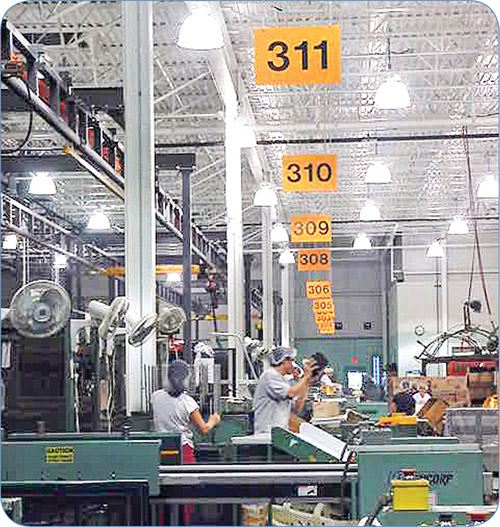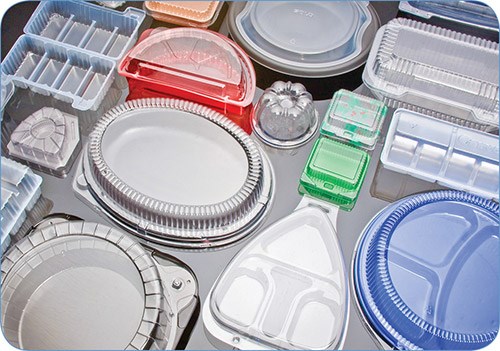‘Back to Basics’ Fuels More Innovation at Thin-Gauge Former
Shift from private to capital ownership give Tray-Pak a boost.
Tray-Pak Corp. was started in 1975 in a manner similar to many others in plastics during that colorful time, fueled more by an entrepreneurial spirit than cash. The family-owned company was launched by the late David Bestwick, who bought and renovated used equipment from an old W.R. Grace plant near the Reading, Pa., facility the thermoformer still calls home.
Since then, Tray-Pak has been broadly recognized as a pioneer and innovator in thin-gauge forming. It got into toolbuilding in 1982 via acquisition, received AIB certification for its food-packaging products in 1995, got ISO certified in 1999, expanded into a third building in Reading in 2003, and opened a Class 8 certified clean room in 2007.
It’s all the stuff of which fast and flexible companies are made, and the honors soon followed. In 2007 it won an innovation award from Ben Franklin Technology Partners of Northeastern Pennsylvania for developing and implementing a production-planning, forecasting, and material-planning system. Two years later, Bestwick was honored as Thermoformer of the Year by the Society of Plastics Engineers.
So what happens when a company immersed in the culture of family ownership, with a workforce of more than 250—many of whom have ties to the company going back 20 years—is suddenly acquired by new investors? That was the situation in 2009, when the Bestwick family sold Tray-Pak to TPC Partners LLC, which currently holds a majority stake in the firm (key employees still hold minority positions).
TPC’s first order of business was to appoint Scott Myers as president/CEO. An engineer, Myers had most recently been executive vp at WinCup, Inc., a leading Georgia-based molder of EPS cups, bowls, and containers.
So forget what you think you know about capital investors, because in the case of Tray-Pak, innovation, sustainability, product development, customer focus, and—perhaps most importantly—safety, continue to be the fuel that power double-digit growth at this thermoformer.
“We’ve had a rich history, and when new ownership came in we wanted to continue the strategy of providing our customers with innovative packaging solutions,” Myers notes. “In fact, we wanted to take that strategy to the next step. Our goal is to generate one new product (i.e., a new tool) a day. We do 1500 different designs a year. And what we’ve found is that 60% of our revenue is from products we launched within the last three years.”
Most might not make the direct connection, but Tray-Pak believes a renewed emphasis on safety—initiated immediately after new ownership came in—has increased its efficiency and the development of new products.
“In two years’ time, we moved to the top 10% in safety in our industry,” remarks Myers. “This can be measured by looking at total recordable incidents, workers’ compensation claims, and the like. Safety drives everything we do. In my career I have never seen innovative products and technology coming from a manufacturing plant where safety wasn’t considered critical.”
Adds Bob Chapleski, director of manufacturing, “We re-energized and reinvigorated our former safety initiatives. We enhanced our safety processes, holding regular Safety Committee meetings that must be attended by all managers. We have safety audits with timely follow-up by key department managers. We’ve invested in safety, and we’ve set up a system of safety accountability.”
FAST AND FLEXIBLE
The charge to generate a new product a day requires Tray-Pak to truly be a part of their customer’s design team. “We provide the full range of what we call ‘up-front’ services to customers,” states Steve Maguire, new product development manager. “We have digital 3D-scanning and rapid-prototyping systems that allow us to get a product sample to a customer in a day or two. Most of our production tools are in aluminum; we build them all here with eight CNC machines. We have AutoCAD, Solidworks, and MasterCam technologies, and we have seven sample thermoformers for quick product runs.
“So all the hardware and software is there to enable us to get to the market quickly,” says Maguire. “But our relationship with our customers is as much of a point of distinction between us and our competitors as the technology we bring to the table.
“We are regularly invited to brainstorm with them at meetings where we try to develop an innovative solution or perhaps solve a problem that they didn’t even know they had. The word ‘partnership’ might be cliché, but that is truly what we strive for. In one instance, where the customer was shaping candy in a mold before packaging it, we were able to design a package that functioned as both the mold and the final package.”
More recently, working with a food-processing customer, Tray-Pak was able to significantly decrease the carbon footprint of a major retailer’s private-label brand. The packaging was redesigned to decrease weight by 12.9%, while maintaining part performance and volume. The redesign significantly lessened the transportation requirements, saving over 2000 gal of fuel and ultimately reducing greenhouse gas emissions by 19 metric tons. Additionally, Tray-Pak used the customer’s finished-goods boxes to ship the packaging to the food-processing facility, saving 24 tons of corrugated from going to a landfill.
Food packaging is at the core of Tray-Pak’s business, accounting for well above half of its orders. It also supplies the medical, consumer goods, and electronic industries. Tray-Pak does no extrusion—its wide array of product offerings are run in quantities ranging from 50,000 to 50 million pieces, making dedicated extrusion lines impractical. Not being tied to one type of extrusion system or another also enables the thermoformer to run a wide range of materials.
“We dabble in it all,” says David Hikes, engineering manager. “We thermoform all types of PET, polystyrene, PVC, PE, and sustainable materials like PLA. No particular kind of material represents more than 30% of the total, and that is not really conducive to doing our own extrusion.”
Recently Tray-Pak became one of the first processors to thermoform UPES resin from Nova Chemical, Monaca, Pa., a PS/PE interpolymer additive that is aimed at broadening the processing window of HDPE. In one application for fresh produce, Tray-Pak ran sheet to make a product that formed 33% faster and with better part aesthetics, faster startup, and lower scrap rate. In another UPES application—this one for institutional food—Tray-Pak developed a package that boosted throughput by as much as 50% while improving part performance 30%, and saving 20% in material usage.
VERSATILE FORMING CAPABILITIES
Tray-Pak runs 40+ cut-in-place and post-trim thermoforming lines from a wide range of suppliers, including SencorpWhite, Brown Machine, and GN Thermoforming Equipment. It runs 100% rollstock and thermoforms products from 6.5 to 70 mils thick. It operates three shifts five days a week. Skeletal scrap is ground and sold to sheet suppliers.
Quality control on all lines is performed every 30 to 60 minutes, and data is tracked electronically for 24/7 access. Tray-Pak’s quality system incorporates GMPs (Good Manufacturing Practices) as outlined in the 21 CFR 110 and AIB’s Food Safety Program. Test data for medical products is stored for three years, and its system allows for full traceability back to raw materials.
Tray-Pak’s new ISO Class 8 clean room brings cutting-edge technology to the thermoformed packaging needs of the medical, electronics, and aerospace industries. The facility is designed to accommodate two state-of-the-art, servo-driven thermoforming lines. Each is equipped with quick-change tooling and integrated process control, which provides production flexibility to efficiently meet volume requirements for quantities from 1000 to 10,000,000 units.
“Tray-Pak was started by an entrepreneur and we never lost the entrepreneurial spirit,” Myers says. “We’ll continue to push safety because that drives performance and supports innovation. We’ll continue to develop one new product a day. We’ll continue to focus not on parts or packages necessarily, but on innovative packaging solutions. We’ll continue to invest in technology that improves our business, and our customer’s business. We’ll continue to be fast…faster than the competition.”
Related Content
Automation in Thermoforming on the Rise
Equipment suppliers’ latest innovations exemplify this trend driven by factors such as labor shortages, higher-speed thermoformers and tighter quality control.
Read MoreSustainable Materials is Focus of Thermoforming Exhibits at K 2022
Thermoforming equipment makers including WM, Kiefel, and OMV will showcase processing of recyclable and biobased materials.
Read MoreThermoforming PCR: An Equipment Supplier’s Pointers
Thermoforming PCR is not radically different from forming virgin, but variation in recycled materials can require extra care to get a consistent end result. Start by examining every aspect of the process from the sheet (and extrusion process if run inline) to the final trim.
Read MoreOMV Technologies Gets New CEO
Kooper brings 33 years of experience in the industrial and consumer packaging industries to OMV--the closed-loop, turnkey, inline extrusion, thermoforming and tooling systems manufacturer.
Read MoreRead Next
Lead the Conversation, Change the Conversation
Coverage of single-use plastics can be both misleading and demoralizing. Here are 10 tips for changing the perception of the plastics industry at your company and in your community.
Read MoreAdvanced Recycling: Beyond Pyrolysis
Consumer-product brand owners increasingly see advanced chemical recycling as a necessary complement to mechanical recycling if they are to meet ambitious goals for a circular economy in the next decade. Dozens of technology providers are developing new technologies to overcome the limitations of existing pyrolysis methods and to commercialize various alternative approaches to chemical recycling of plastics.
Read MoreTroubleshooting Screw and Barrel Wear in Extrusion
Extruder screws and barrels will wear over time. If you are seeing a reduction in specific rate and higher discharge temperatures, wear is the likely culprit.
Read More






















.png;maxWidth=300;quality=90)
 (2).jpg;maxWidth=300;quality=90)









